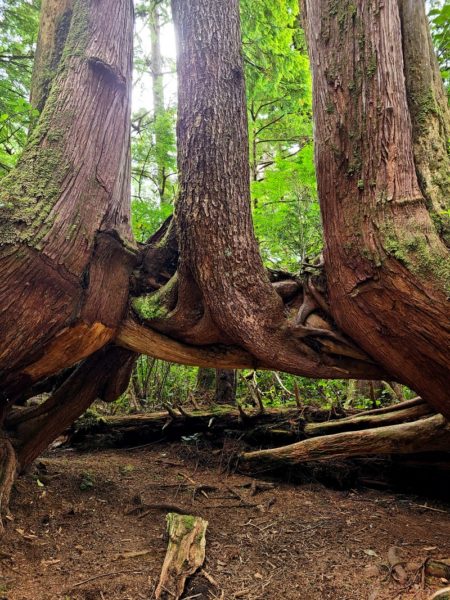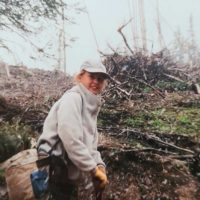Do Trees Feel Time?

“Just remember, green side up”, the foreman joked as I was standing for the first time in a clearcut near Prince George, B.C. with three large white canvas bags belted to my waist, filled with pine seedlings wrapped in bundles of twenty. My job was to plant these plugs (roots) into the ground with my special pointy tree planting shovel – straight up and down and not squished into a hole too small. If the foreman found “J” roots, you would have to replant. This was the start of a decade long life shaping tree planting career. Trees, especially the conifers of the West Coast, have inspired me so much over the years since then. I often think about how we are related with these valuable entities and what we might learn from them.
During my tree planting years I visited endless clearcuts, planting around stumps that marked the absence of previously tall standing fir, pine, spruce, hemlock and cedar. The notion that the small tufts of green I was planting were supposed to replace such a solid former reality, seemed foolhardy. I would plant a tree and turn around to never to see it again, supposedly to expect that these seedlings will survive drought or dumps of snow to become resilient tall trees. Actually, what happens is that, if lucky, they will become a second growth forest – a plantation of trees all the same age, convenient for harvesting but also often less resilient to pests, disease and fire – a fate that would have met some of my planted trees.
I now thankfully spend more time in forests than clearcuts. Trees left standing are a testament to other types of value besides money – especially old growth forests which sequester carbon in the ground and as scientists are recently discovering, an even larger amount in their canopy. They release oxygen. Forests are habitat for so many animals, especially dead trees: left standing, they are homes to insects, owls, bats, woodpeckers, small mammals, and even sometimes bears. The mental health benefits of what the Japanese call “forest bathing” is well documented. I even read once that when people can see green outside a hospital window that they heal faster.
Walking through a forest I often think I am probably barely registering the very tip of what is actually happening there – the local language and lives of the resident plants and animals. Furthermore, who knows what has unfolded on the land over centuries, or even millennia and how these trees got here in the first place? I don’t know if our human brain is meant to grasp life over such a long time span; this might require another type of consciousness (or maybe just a trained science brain). We now know that trees actually communicate with each other through an underground mycelium network. I doubt they are sharing the forest gossip, but they share resources during times of scarcity and send each other chemical warnings about an observed threat in the environment. We are not just observing trees, they may be observing us too.
Some of the most wild forests in the world are on the West Coast of Vancouver Island – the sheer amount of wind and rain – inhospitable to humans – feels like Mexico to trees. Trees grow quickly in these conditions and in combination with the wind, can twist into spirals or assume untreelike shapes. Fallen trees become “nurse logs” supporting a kindergarten of young trees all in a row. As rot quickly sets in the nurse eventually disappears, leaving these saplings with their roots in the air, like long immobile legs. Trees tipping over will try to steady themselves by putting out new roots, sometimes a branch looks like it is now a root. Dead standing trees, with bark fallen off and large black holes where their branches were, take on a new presence like ghosts from the past trying to tell us something. Visiting a West Coast forest is like seeing a drama unfolding in slow motion, each tree having its own unique character forged through it’s particular, ever changing conditions. There are no rules in this type of forest – it is more “go with the flow”. You never know what outcome of this kind of wild creativity you are going to encounter beyond the next bend in a trail.
Trees, in combination with human ingenuity, have made so many amazing things and we depend on them for so many materials: wood, heat, toilet paper. Only, typical for us, by turning nature into industry, we take too much, waste too much, and money becomes the guiding force for making decisions. Wild forests become ‘predictable’ tree farms which we manage with an annual allowable cut and measure with terms such as “stems per hectare” – using a language that monetizes the land and distances us from a feeling of connection to these beings. In contrast to trees, us short-lived humans have a selfish and myopic vision that does not favor long term growth.
Rather than seeing ourselves as the centre of the universe, what if we imagined trees as intelligent co-habitants of the world? If we learned how to tap into their network of consciousness like in the movie “Avatar”, what would they say, or what would we learn from their silence? Would we just automatically feel a more informed connection to a community around us? Maybe we would be shown the value of striving to grow in one place despite all impediments, naturally becoming a welcome and non-judgemental, helpful presence to others. Or would we know time is our friend because it makes us wiser and stronger, and that when the end comes, we are still an essential part of the forest. Does a tree feel time?
In treeplanting, a piecework job, I learned to be as efficient and fast as possible in order to make as much money as I could in a day. It is exhilarating to perfect a skill, become extremely physically fit, be part of a group of planters and also to be able to pay for university yourself. These positive aspects of the job allowed you to overcome just seeing yourself as another cog in the big industry money making machine. Being outside and in the dirt, we connected to the earth and to each other and matured as humans through the process. So my relationship to trees is not clear cut.
When a tree is cut down, a beautiful design of repeating lines – tree rings – are exposed. It’s almost magical to see how the tree has been counting the years up to that moment. Despite all these varied circumstances, in the end, we – and the trees – are connected and bound by the same rules of time, a circle for each year. Hopefully the similarities we uncover between us and the natural world help us to pay more attention, feel some affinity with our wild neighbors and open us up to learning valuable lessons.
To learn more about trees and nature, in an accessible way check out: “Nerdy About Nature” – you might enjoy this 6 minute video where he gets a bit philosophical: The Poetic Beauty of Nature’s Resilience – Universal Lessons and Daily Inspiration From the Trees
Photo above: On trail to San Josef Bay – trees helping each other out, Vancouver Island, B.C.
Photo below: Me treeplanting in the snow, circa 1992


